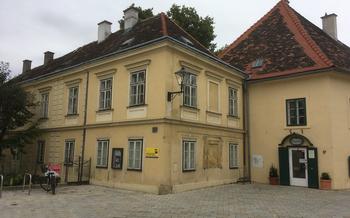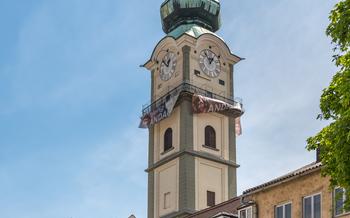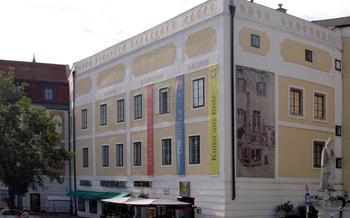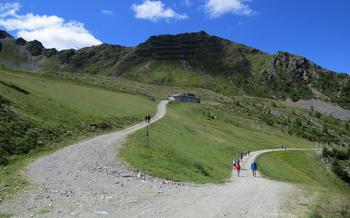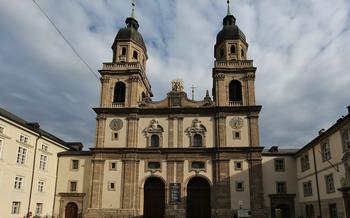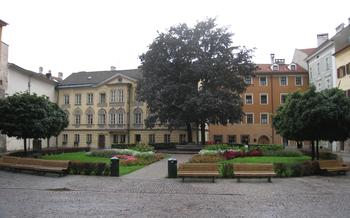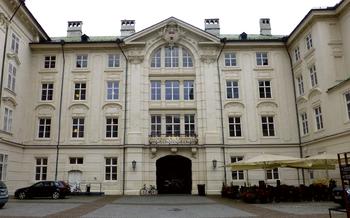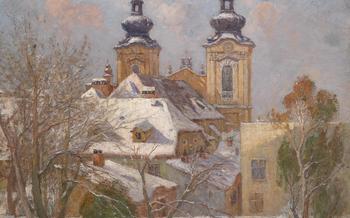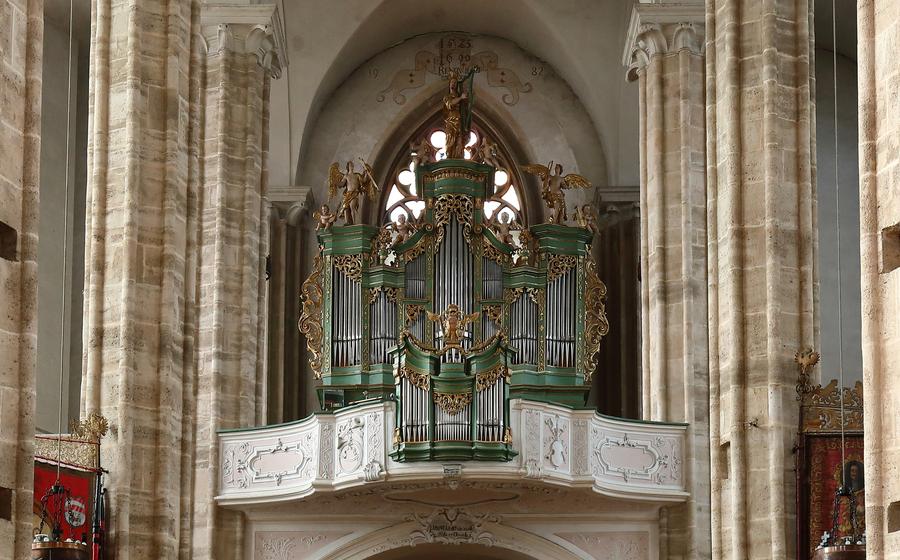
St. Othmar Kirche
- St. Othmar Kirche: A Stunning Historical Gem
- Exploring the Interior of St. Othmar Kirche
- The Altar and Its Significance
- The Organ and Its Melodious Sounds
- The Frescoes and Their Stories
- Strolling Through the Churchyard
- Attending a Church Service
- Unveiling the History of St. Othmar Kirche
- Tips for Photography Enthusiasts
- Accessibility and Visiting Hours
- Making the Most of Your Visit
- Planning Your Visit
- Dress Code and Etiquette
- Local Cuisine and Dining Options
- Transportation and Getting There
- Insider Tip: Hidden Gems and Secret Spots
St. Othmar Kirche: A Stunning Historical Gem
Amidst the vibrant city of Mödling, a captivating historical gem awaits discovery - the St. Othmar Kirche. This magnificent church stands as a testament to the city's rich heritage, showcasing a harmonious blend of architectural styles that have shaped its unique identity. Constructed in the 15th century, the church underwent several expansions and renovations over the centuries, resulting in a captivating fusion of Gothic, Renaissance, and Baroque elements.
As you approach the church, its imposing facade commands attention, adorned with intricate stone carvings, ornate buttresses, and a striking steeple that pierces the sky. The church's exterior is a testament to the skill and artistry of its builders, who meticulously crafted each detail to create a visually stunning masterpiece. Step inside, and you'll be transported to a realm of awe-inspiring beauty as the church's interior unfolds before your eyes.
Exploring the Interior of St. Othmar Kirche
Step inside the imposing St. Othmar Kirche, and prepare to be captivated by its awe-inspiring interior. The nave, with its soaring vaulted ceiling, creates a sense of grandeur and reverence. As your gaze sweeps across the space, you'll notice the intricate ribbed vaulting, supported by elegant pillars that lend a sense of lightness and grace to the structure.
The walls of the church are adorned with stunning frescoes, vibrant in color and rich in symbolism. These intricate paintings depict scenes from the life of St. Othmar, the church's patron saint, as well as other biblical narratives. Each fresco tells a story, inviting visitors to contemplate the deeper meanings and messages they hold.
Among the notable artworks within the church, the stained glass windows stand out for their exquisite craftsmanship and radiant beauty. These windows, bathed in natural light, cast a kaleidoscope of colors onto the interior, creating an ethereal and mystical atmosphere. Each window depicts a different saint or biblical figure, adding to the church's rich iconography.
The high altar, a masterpiece of Baroque art, is a sight to behold. Intricately carved and adorned with gold leaf, the altar features a stunning altarpiece depicting the Assumption of Mary. This breathtaking artwork, with its lifelike figures and vibrant colors, is a testament to the skill and artistry of its creator.
The Altar and Its Significance
The main altar of St. Othmar Kirche is an awe-inspiring masterpiece that commands attention with its intricate design and profound symbolism. Crafted from the finest materials, the altar features a stunning altarpiece that depicts the life and martyrdom of St. Othmar, the church's patron saint. The central panel portrays the saint's unwavering faith and dedication as he faces persecution and ultimately meets his demise. The vibrant colors and expressive figures bring the story to life, evoking a sense of reverence and inspiration within the hearts of the faithful.
The altar's historical significance is deeply intertwined with the church's origins. Commissioned in the 15th century, the altar serves as a testament to the enduring legacy of St. Othmar and the unwavering devotion of the Mödling community. Over the centuries, the altar has undergone meticulous restoration and renovation efforts, ensuring its preservation for generations to come. These careful interventions have maintained the altar's original splendor while preserving its historical integrity, allowing visitors to appreciate its beauty and symbolism in all its glory.
The Organ and Its Melodious Sounds
The St. Othmar Kirche is home to a magnificent organ that has captivated visitors and locals alike with its melodious sounds for centuries. Constructed in the early 18th century by renowned organ builder Johann Ignaz Egedacher, this remarkable instrument boasts an impressive 24 stops and two manuals, making it one of the most significant organs in the region.
The organ's intricate carvings and ornate decorations add to its visual appeal, blending seamlessly with the church's Baroque architectural style. Its rich and varied tones reverberate throughout the sacred space, creating an atmosphere of awe and reverence.
Over the years, the organ has undergone meticulous restoration and maintenance to ensure its continued functionality and pristine condition. Skilled organists and musicians from around the world have graced the St. Othmar Kirche with their performances, filling the air with enchanting melodies and harmonies.
Regular organ concerts are held at the church, providing visitors with an opportunity to witness the instrument's capabilities and appreciate the talents of accomplished organists. These concerts showcase a diverse repertoire, ranging from classical masterpieces to contemporary compositions, leaving a lasting impression on attendees.
Whether you are a music enthusiast, a history buff, or simply seeking a moment of tranquility, the St. Othmar Kirche's organ is a must-see attraction. Its melodious sounds and historical significance make it an integral part of the church's rich heritage.
The Frescoes and Their Stories
The interior of St. Othmar Kirche is adorned with a series of captivating frescoes that narrate biblical tales and depict scenes from the life of St. Othmar. These vibrant and intricate artworks were meticulously crafted by skilled artists during the Gothic period, and they remain a testament to the enduring power of religious art.
One of the most striking frescoes depicts the crucifixion of Jesus Christ. The Savior's body is rendered with exquisite detail, his face contorted in agony yet radiating a sense of divine peace. The surrounding figures of Mary, John the Evangelist, and other mourners convey the depth of their grief and sorrow.
Another notable fresco portrays the martyrdom of St. Othmar. The saint is depicted standing defiantly before his executioners, his eyes fixed heavenward as he prepares to meet his maker. The surrounding crowd is a mixture of awe and horror, as they witness the unwavering faith of this holy man.
These frescoes are not merely decorative elements; they serve as a powerful means of conveying religious messages and inspiring the faithful. They invite viewers to reflect on the life, suffering, and resurrection of Jesus Christ, and to emulate the unwavering faith of St. Othmar.
Strolling Through the Churchyard
Surrounding the St. Othmar Kirche lies a tranquil churchyard, inviting visitors to explore its history-laden grounds. As you wander through the churchyard, you'll encounter a series of intriguing tombs, monuments, and sculptures that tell the stories of Mödling's past residents.
Among the notable tombs, the resting place of the church's founder, St. Othmar, stands out. Elaborately adorned with intricate carvings and inscriptions, his tomb serves as a testament to his enduring legacy. Other notable tombs include those of prominent figures from Mödling's history, each with its unique story to tell.
The churchyard also features several striking monuments and sculptures that add to its historical charm. The war memorial, commemorating the sacrifices made by Mödling's citizens during various conflicts, stands as a poignant reminder of the town's resilience. Various other sculptures, depicting religious figures or scenes, grace the churchyard, adding to its serene atmosphere.
Attending a Church Service
The St. Othmar Kirche invites visitors to immerse themselves in the spiritual atmosphere of a traditional Catholic service. Every Sunday, the church holds a morning mass, typically starting at 10:00 AM. Visitors are welcome to join the local congregation and experience the sacred rituals and prayers. The service is conducted in German, providing an opportunity for visitors to witness the local language and traditions.
The St. Othmar Kirche service follows a structured format, commencing with an opening hymn and prayer. The priest leads the congregation through readings from the Bible, followed by a homily or sermon. The centerpiece of the service is the celebration of the Eucharist, where bread and wine are consecrated and distributed among the attendees. The service concludes with prayers, hymns, and a final blessing.
For visitors who wish to attend a service, it is recommended to arrive a few minutes early to find a seat. The church encourages a respectful and prayerful demeanor during the service. Visitors are welcome to participate in the prayers and responses, but it is not mandatory. Whether you are a practicing Catholic or simply seeking a spiritual experience, attending a service at the St. Othmar Kirche offers a glimpse into the religious traditions and community of Mödling.
Unveiling the History of St. Othmar Kirche
St. Othmar Kirche holds within its walls a rich tapestry of history, intertwining the lives of the faithful and the evolving landscape of Mödling. Its construction commenced in the 14th century, a testament to the deep-rooted faith of the local community. Over the centuries, the church underwent several expansions and renovations, each leaving its own unique mark on the structure.
In the 16th century, the church was adorned with intricate frescoes, adding a touch of artistic splendor to its sacred space. These frescoes, depicting scenes from the Bible and the lives of saints, have been meticulously preserved, offering visitors a glimpse into the artistry and devotion of past generations.
A significant milestone in the church's history came in the 18th century when it was elevated to the status of a parish church. This elevation reflected the growing importance of the church and its role as a spiritual center for the community. Throughout the years, St. Othmar Kirche has stood as a steadfast witness to countless baptisms, marriages, and funerals, bearing silent testimony to the joys and sorrows of generations of Mödling residents.
During the turbulent periods of war and conflict, the church offered solace and refuge to the people of Mödling. Its sturdy walls provided a sense of security and comfort, reminding them of the enduring presence of faith amidst the chaos of the outside world.
Today, St. Othmar Kirche stands as a living testament to the enduring spirit of the Mödling community. Its historical significance and architectural beauty make it a must-visit destination for anyone seeking to delve into the rich cultural heritage of the region.
Tips for Photography Enthusiasts
St. Othmar Kirche presents a treasure trove of photographic opportunities for enthusiasts of all skill levels. To capture the church's grandeur in all its glory, consider the following tips:
-
Position and Perspective: Experiment with different angles and perspectives to create dynamic compositions. Capture the church's facade from a low angle to emphasize its towering height or step inside to capture the soaring interior from below.
-
Lighting Conditions: Plan your visit during the golden hours of sunrise or sunset to capture the warm, diffused light that bathes the church in a magical glow. Soft, overcast days also provide even lighting for capturing intricate details.
-
Architectural Details: Pay attention to the intricate carvings, sculptures, and stained glass windows that adorn the church's exterior and interior. These details add depth and character to your photographs.
-
Symmetry and Lines: Utilize the church's symmetrical design and leading lines to create visually pleasing compositions. The church's arched doorways, columns, and vaulted ceilings offer ample opportunities for creative framing.
-
Interior Ambiance: Capture the church's serene and contemplative atmosphere by including elements such as flickering candles, stained glass light filtering through the windows, or the soft glow of the altar.
Accessibility and Visiting Hours
Making the Most of Your Visit
The St. Othmar Kirche welcomes visitors from all walks of life, regardless of their physical abilities or religious beliefs. The church is wheelchair-accessible, ensuring that everyone can comfortably explore its sacred spaces. Visitors can obtain information about guided tours or schedule private visits by contacting the church office in advance.
Planning Your Visit
To fully appreciate the beauty and tranquility of the St.
Dress Code and Etiquette
When visiting St. Othmar Kirche, it's essential to observe proper dress code and etiquette. The church is a sacred space, and visitors should dress respectfully, avoiding overly casual or revealing attire. While there is no strict dress code, it's generally recommended to wear modest clothing that covers the shoulders and knees. For men, a collared shirt and dress pants or chinos are appropriate, while women can opt for a dress, skirt, or pants paired with a blouse or sweater. Short shorts, tank tops, and flip-flops are best avoided.
Beyond attire, visitors should also be mindful of their behavior inside the church. Maintaining silence and refraining from disruptive activities is crucial. Respecting the sanctity of the space is of utmost importance, so visitors are encouraged to avoid talking loudly, taking photos with flash, or using their mobile phones during services or prayer. If you need to leave during a service, do so quietly and discreetly. By adhering to these simple guidelines, visitors can contribute to a peaceful and reverent atmosphere within St. Othmar Kirche.
Local Cuisine and Dining Options
A visit to Mödling is not complete without savoring the delectable local cuisine. In the vicinity of St. Othmar Kirche, you'll find an array of charming restaurants and cafes that offer a delightful culinary experience. Indulge in traditional Austrian dishes that showcase the region's rich flavors and culinary heritage.
Must-Try Dishes:
- Wiener Schnitzel: A quintessential Austrian dish, this breaded and fried cutlet is a must-try for meat lovers.
- Tafelspitz: Tender beef boiled in broth and served with various accompaniments, including horseradish sauce.
- Kaiserschmarrn: A fluffy shredded pancake, often served with powdered sugar and fruit compote.
- Salzburger Nockerl: A unique dessert featuring three airy soufflé dumplings served with powdered sugar.
Recommended Restaurants:
- Gasthof Kirchenwirt: Located just steps from St. Othmar Kirche, this traditional Austrian restaurant offers a cozy ambiance and hearty local dishes.
- Cafe Restaurant Sissi: Enjoy a delightful meal in a charming setting while taking in the picturesque views of Mödling.
- Zum Schwarzen Kameel: A local favorite known for its authentic Austrian cuisine and friendly atmosphere.
Tips for Finding Authentic Dining Experiences:
- Seek Out Local Markets: Explore the local markets to discover fresh produce, artisanal cheeses, and homemade delicacies.
- Ask for Recommendations: Don't hesitate to ask locals or your hotel concierge for recommendations on hidden culinary gems.
- Venture Off the Beaten Path: Step away from the main tourist areas to find authentic restaurants frequented by locals.
Transportation and Getting There
Getting to St. Othmar Kirche is a breeze, thanks to the well-connected public transportation system in Mödling. The Kirche is conveniently located within walking distance from the Mödling train station, making it easily accessible by rail. Simply hop on a train to Mödling, and once you arrive, follow the signs or ask for directions to the church.
For those who prefer to drive, there are several parking options available in the vicinity of the church. The closest parking garage is the Parkgarage Mödling, located just a short walk away. Street parking is also available, but it's important to note that these spots are limited and may require some patience, especially during peak tourist season.
Once you're in the area, exploring on foot is the best way to appreciate the charm of Mödling and its historic center. The church is situated in the heart of the old town, surrounded by narrow cobbled streets, inviting cafes, and charming boutiques. Whether you choose to walk, take public transportation, or drive, getting to St. Othmar Kirche is a hassle-free and enjoyable experience.
Insider Tip: Hidden Gems and Secret Spots
Beyond the main attractions, St. Othmar Kirche offers hidden gems and secret spots for those seeking a deeper connection with its history and beauty. One such gem is the hidden crypt, which can be accessed through a discreet door in the sacristy. This atmospheric space, dimly lit by flickering candles, houses the remains of past priests and notable figures from Mödling's history.
Another secret spot is the small garden adjacent to the church, accessible through a side door. This tranquil oasis, often overlooked by visitors, offers a moment of respite and contemplation amidst the vibrant city life. The garden features a serene fountain, colorful flower beds, and a bench where one can sit and soak in the peaceful ambiance.
For those with a keen eye for detail, the church's exterior holds hidden treasures. Look for the intricately carved gargoyles perched on the roof, each with a unique expression and story to tell. These mythical creatures, often overlooked, add a touch of whimsy and intrigue to the church's facade.
Remember that these hidden gems and secret spots are best experienced with a sense of respect and appreciation for the sacredness of the church. Tread softly, observe silence, and savor the unique opportunity to connect with the church's rich history and spiritual essence.
